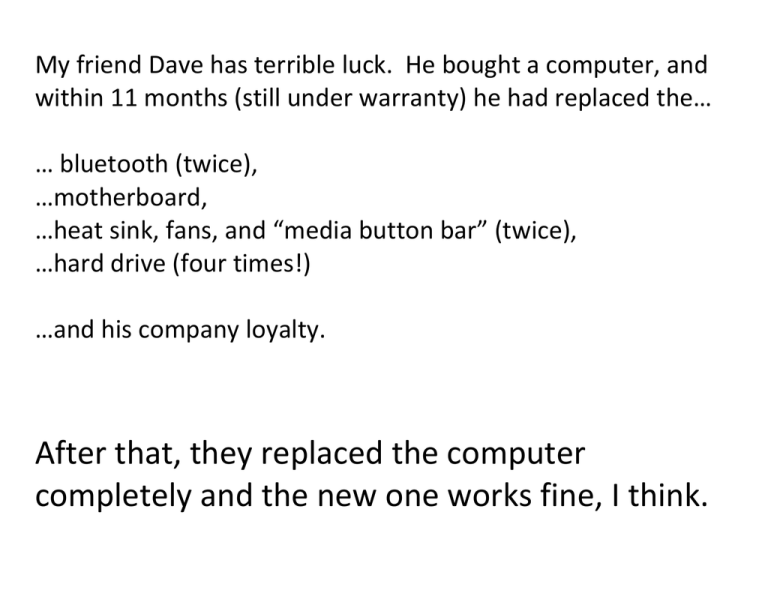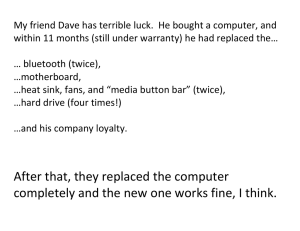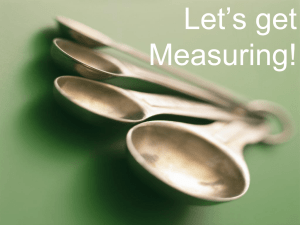My friend Dave has terrible luck. He bought a... within 11 months (still under warranty) he had replaced the…
advertisement

My friend Dave has terrible luck. He bought a computer, and within 11 months (still under warranty) he had replaced the… … bluetooth (twice), …motherboard, …heat sink, fans, and “media button bar” (twice), …hard drive (four times!) …and his company loyalty. After that, they replaced the computer completely and the new one works fine, I think. When a product is a dud, it’s expensive. To limit risks a company needs to know the chances of a product failure or not being the advertised weight. The computer company needs to know the chances (probability) that a laptop will fail in the first 1, 2, or 3 years. On a $1500(ish) laptop • Dell offers 1 year ‘free’ basic warranty. • Extend the warranty to 2 years $160 • Extend the warranty to 3 years for $230 • Extend the warranty to 4 years for $370 The chance of costly repairs increases with time, so the price of the warranties goes up as they get longer. The company still needs to make money, knowing the chance of failure sets the price. Knowing the probability of a repair means that they can set the price to, on average, pay out less than they charge for warranty costs. • Some machines won’t incur costs • Other machines are doomed to eat company profits Probability is the likelihood of a specific event out of ______________________ • Probability = Number of times a specific event can occur ÷ by Total Number of times that any event can occur. (this is an important slide) Example: Ratio of the number of computers that fail out of the number of computers produced. Pr(failure in year 1) = 32 Million Failed Computers ---------------------------500 Million Computers Pr(failure in year 1) = ______________________ (So that ‘free’ warranty costs the company 6.4% of the repair cost) Example: Roll up the Rim. Pr(WINNER!) = Winning cups -----------------------Total cups (In 2011) There were 45 million winning cups -----------------------------------And 270 million cups in total Pr(WINNER!) = … just as advertised. Probability is always between ___________, inclusive. If something never happens, it has ___________probability. Pr(winning an angry raccoon) = 0 cups / 270 million 0 / anything = 0. Pr(winning an angry raccoon) = 0 If something is ___________to happen it has probability one. Pr(the cup was red) = 270 million / 270 million Anything divided by itself is ___________ We’re also assuming complete ___________. That means that every cup is equally likely. If you know the winning cups in advance, Pr(you winning) is not 1/6. Random is not the same as haphazard, spontaneous, or crazy. Pointing out things like this out alot will help if you have too many friends. Probability is the long term ___________of events of interest to the total number of all possible events that occur. Example: Flip a coin. Pr(heads) = Times a coin comes up heads… EVER!! --------------------------------------------------------Times a coin is flipped…. EVER!! Assume all coins are the same, this probability should come up as An event either happens or it doesn’t. This is certain. That means the chance of an event either happening or not happening is ___________ . We can use this to find the chance of something not happening. Pr(Winning cup) + Pr(Losing cup) = 1 So Pr(Losing cup) = 1 – Pr(Winning cup) Pr(Losing cup) = If one in every six cups is a winner. Then the other five cups in six are losers. In general, the ______________________is: (this is important) You can find the probability of more complex events by composing them of simpler events. If two events are ___________, meaning they don’t affect each other, then the chance of BOTH of them happening is two probabilities ___________ Pr( Winning cup AND flipping a coin heads) = 1/6 x 1/2 = 1/12 Example: Cards In standard deck of 52 cards, there are 4 suits and 13 ranks. Suit and rank are independent. Pr(Ace of Spades) = Pr(Ace) x Pr(Spade) = 1 rank /13 ranks x 1 suit / 4 suits = = There is 1 Ace of Spades in a deck of 52 cards. 11th ed, Page 140 and 141 have some very good examples. The general rule, called the ______________________, is: Pr(A and B) = Pr(A) x Pr(B) When A and B are independent. If we take two events that ______________________, the probability of one event OR the other happened is the two probabilities ______________________. Pr( Vancouver OR Toronto is voted the best city) = Pr( Vancouver is best) + Pr(Toronto is best) They can’t both be the best city, so these events never happen together. Note: Another term for ‘never happening together’ is ______________________ Example: A lottery machine picks a single number from 1 to 49. Pr( Machine picks 1 or 2) = Pr( Picks 1) + Pr(Picks 2) = The general rule, called the ______________________ is that Pr(A OR B) = Pr(A) + Pr(B) … when A or B can’t happen together. We could also have written Pr( Picks 2 or less) = 2/49 For that matter, we could have written… Pr( Picks 3 or less) = Pr(Picks 1) + Pr(Picks 2) + Pr(Picks 3) Can you guess: Pr( Machine picks 10 or less) (A machine picks a single number from 1 to 49) How about… Pr(Machine picks 49 or less) Ah, wise grasshopper, but what of… Pr(Machine picks 11 or MORE) (Hint: use previous two answers) Now for the true test of a warrior’s spirit: Two six-sided dice are rolled. (Rolls are independent) Pr( First die rolls a 3) = Pr( Both dice roll 3s) = In case you were wondering, there are dice of other than sixsides. (for interest) Guess why the one on the right is bad? So Probability = Number of ways a specific event can occur ÷ by Total number of ways that any event can occur. Or in short: P(event) = Nevent / Ntotal In short: P(event) = Nevent / Ntotal Another prespective: P(event) = Nevent / (Nevent + Nnot event) Example: There are 7 women and 5 men in a group. Choose one at random. Pr(Woman) = Nwomen/ (Nwomen + Nmen) Next lecture More examples with probability The normal distribution Probability and the normal distribution Getting Z scores (4-1) Z table borders Thanks to Dr. Dave Campbell for letting me borrow heavily from his slides for this section.




